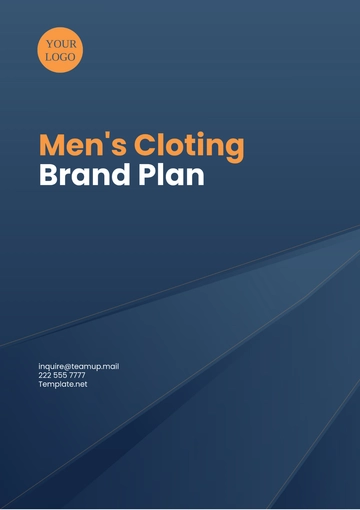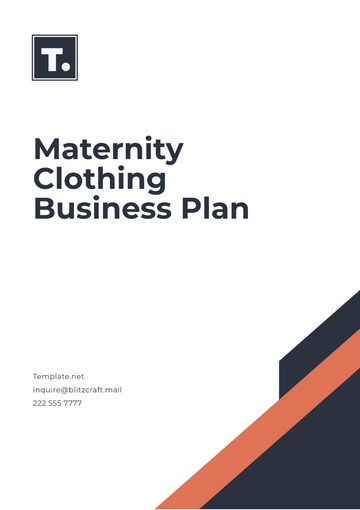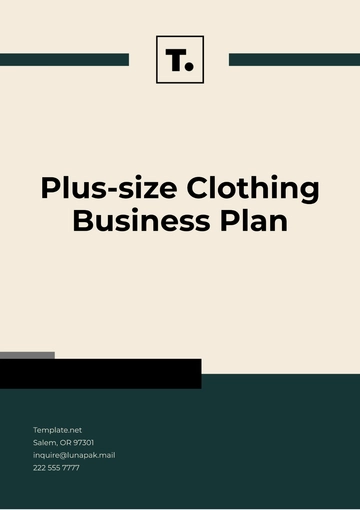Free Clothing Plan

I. Executive Summary
[Your Company Name] aims to become a leading fashion brand known for trendsetting designs and exceptional customer service by providing stylish, high-quality, and affordable clothing through a retail and e-commerce store, with goals to launch a flagship store and online shop within the first year, achieve $500,000 in revenue by the end of the second year, and expand product lines to include accessories and footwear by the third year.
II. Business Description
Company Overview: [Your Company Name] will offer a curated selection of contemporary clothing for men and women. Our focus will be on trendy, high-quality items that appeal to a broad age range, from young adults to middle-aged customers.
Market Need: There is a growing demand for unique and stylish clothing at affordable prices. Consumers are seeking brands that provide both quality and fashion-forward designs.
III. Market Analysis
A. Industry Overview
The fashion industry is a dynamic and rapidly changing sector, driven by trends, seasonality, and consumer preferences. With the rise of e-commerce, more consumers are shopping online, creating a significant opportunity for new entrants.
B. Target Market
Demographics: Ages 18-45, both genders, middle to upper-middle-income brackets.
Geographics: Urban and suburban areas, with a primary focus on the United States initially.
Psychographics: Fashion-conscious individuals who value quality and style.
C. Market Trends
Increased online shopping and mobile commerce.
Growing interest sustainably and ethically.
Demand for personalized and unique fashion items.
D. Competitive Analysis
Direct Competitors: Zara, H&M, Forever 21
Indirect Competitors: Local boutiques, high-end designer brands
E. SWOT Analysis
Strengths: Unique product offerings, strong online presence, flexible supply chain.
Weaknesses: Limited brand recognition initially, reliance on seasonal trends.
Opportunities: Expansion into international markets, and collaborations with influencers.
Threats: Intense competition, and economic downturns affecting consumer spending.
IV. Marketing Strategy
A. Brand Positioning
[Your Company Name] will position itself as a trendy, affordable, and quality fashion brand that offers unique designs not typically found in mainstream stores.
B. Marketing Channels
Digital Marketing: Social media campaigns, influencer partnerships, email marketing.
Traditional Marketing: Print advertisements, fashion events, pop-up shops.
E-commerce: SEO optimization, online ads, user-friendly website with a strong mobile interface.
C. Sales Strategy
Launch promotions and discounts.
Develop a loyalty program to encourage repeat customers.
Offer exclusive online-only collections to drive web traffic.
V. Product Line
A. Initial Product Offerings
Casual wear: T-shirts, jeans, and casual dresses.
Formal wear: Suits, blazers, and evening dresses.
Seasonal collections: Summer and winter lines with appropriate accessories.
B. Product Development
The design team will create unique, trendsetting items.
Regularly update collections to keep up with fashion trends.
VI. Operations Plan
A. Location
Flagship store in a prime urban location.
Warehousing facilities for inventory management.
B. Suppliers
Establish relationships with reliable suppliers for quality materials.
Ensure a diverse supply chain to avoid disruptions.
C. Production
In-house design team.
Outsourced manufacturing to keep costs manageable.
D. Technology
Robust e-commerce platform with integrated inventory management.
Customer relationship management (CRM) system to track and analyze customer interactions.
VII. Management Team
CEO/Founder: [Your Name] - Experienced in retail management and fashion design.
COO: Agustin Jerde - Background in operations and supply chain management.
CMO: Reyes Bayer - Expertise in digital marketing and brand strategy.
VIII. Financial Plan
A. Startup Costs
Expense | Amount |
|---|---|
Store setup and renovations | $200,000 |
Initial inventory | $100,000 |
Marketing and promotion | $50,000 |
E-commerce platform | $20,000 |
Working capital | $30,000 |
Total | $400,000 |
B. Revenue Projections
Year | Revenue |
|---|---|
Year 1 | $250,000 |
Year 2 | $500,000 |
Year 3 | $750,000 |
C. Funding Requirements
Seeking $400,000 in startup capital through a combination of personal savings, investor funding, and small business loans.
IX. Appendix
Detailed financial projections and statements.
Market research data.
Resumes of the management team.
Product sketches and design concepts.
- 100% Customizable, free editor
- Access 1 Million+ Templates, photo’s & graphics
- Download or share as a template
- Click and replace photos, graphics, text, backgrounds
- Resize, crop, AI write & more
- Access advanced editor
A Clothing Business Plan is a detailed document that outlines the strategic direction, goals, and operational plan for a business in the apparel industry. It includes information on the company's vision, market analysis, marketing strategies, financial projections, and operational procedures. The plan serves as a roadmap for starting and growing a clothing business, whether it's a fashion boutique, an online store, or a large-scale manufacturing operation.
You may also like
- One Page Business Plan
- Coffee Shop Business Plan
- Restaurant Business Plan
- Food Business Plan
- Real Estate Business Plan
- Executive Summary Business Plan
- Cover Page Business Plan
- Nonprofit Business Plan
- Daycare Business Plan
- Construction Business Plan
- Startup Business Plan
- Medical Business Plan
- Bakery Business Plan
- Service Plan
- Hotel Business Plan
- Catering Business Plan
- School Business Plan
- Healthcare Business Plan
- Transportation Plan
- Sports Plan
- Car Wash Business Plan
- Salon Business Plan
- Clothing Business Plan
- Farming Business Plan
- Boutique Plan






























